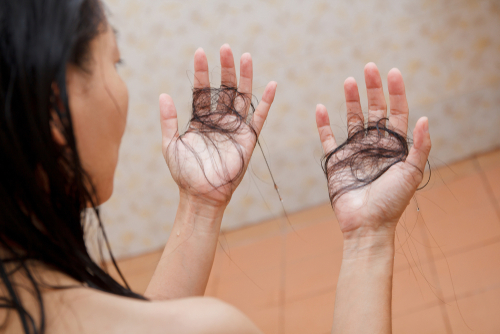No products in the cart.
Hair Falling Out: The Cause and the Remedies

Hair loss, falling out of hair, or hair thinning are commonly caused by genetic factors, hormonal changes, medical conditions, medications, and the overall aging process, which starts in your thirties and forties. It may either be temporary or more complex and is most likely experienced by men but not uncommon to women. Some people prefer to let their baldness or thinning of hair be untreated, but you can choose to prevent or restore your hair’s growth. (Image Credit: Shutterstock)
Here are the following factors that can cause hair thinning or hair loss:
1. Temporary hair loss
- Physical or emotional stress – Physical or emotional trauma caused by an accident, surgery, giving birth, or severe illness may cause your hair to thin out.
- Protein, vitamin B, or iron deficiency – The growth of new hair follicles is impeded by the decreased intake of protein, iron, or vitamin B.
- Excess vitamin A – When you take too many supplements or medications containing vitamin A, your hair will reach the end of its growth phase quickly and fall out. If your body can’t keep up with the hair replacement, baldness results.
- Female hormones – Taking contraceptives or discontinuing them and conditions that affect your hormonal balance such as polycystic ovary syndrome (PCOS), menopause, pregnancy, and hysterectomy drive your hair follicles into dormancy.
- Drastic weight loss – The sudden drop of minerals or vitamin intake due to poor diet or eating disorders like anorexia and bulimia can cause hair thinning.
- Chemotherapy – The drugs used in chemotherapy destroys rapidly dividing cells such as cancer cells and the cells in your hair roots.
- Hairstyles or hair treatments – Excess use of hair products and treatments such as coloring, hair straightening, oil treatment, or perms put pressure on the follicles when you pull it back very tightly. The heat from these products and treatments also boils the water in your hair shaft, which generally results in temporary hair loss.
2. Complex Hair Loss
- Heredity – Male and female pattern baldness is a condition that results from a combination of hormone levels, the aging process, and genetics.
- Underactive or overactive thyroid activity – The hormones produced by the thyroid gland influence many processes in your body, including hair development. The overproduction or underproduction of such hormones can cause hair loss.
- Medications or drugs – If you are on medication for high blood pressure, cancer, arthritis, or heart problems, you may experience hair loss as a side effect.
- Trichotillomania – This is the impulse pulling of your hair that destroys the hair follicles, resulting in the thinning of hair.
If you want to restore your hair back to its former glory, there are a number of remedies that you can try. Here are some of them.
1. Nonmedical solutions or home remedies
Hair loss caused by drugs, chemical exposure, and medical illness requires no treatment and will stop when you discontinue using the medication or drugs that are causing it. The unhealthy diet that causes gradual thinning of hair must be changed to a healthy one to restore minerals and vitamins needed for healthy hair growth. You may also wear wigs or hair weaves while waiting for your hair to grow back.
2. Medications
Treatments of an underlying disease such as fungal scalp infection, pattern baldness, or alopecia areata include but are not limited to oral medication or injection of corticosteroid. Other treatments can be done through the application of creams, liquid, or foam into the scalp to calm the damaged or inflamed hair follicles caused by harsh chemicals. You need to use them regularly, though, for several months to achieve desired results.
3. Hair transplant
Hair restoration surgical procedures involve the placement of hair follicles to bald areas. Nowadays, some clinics such as Vera Clinic offer effective surgical and nonsurgical hair transplants. The following are two ways to perform hair graft:
- Follicular unit transplantation (FUT) or hair transplant strip method
This method is recommended to people with large bald areas. FUT involves the removal of chunks of hair from areas with thick hair and transferring them to bald areas. Its result shows no telltale signs of surgery because the transplant follows the natural hair growth pattern.
- Follicular unit extraction (FUE)Unlike the FUT, FUE is a technique wherein the hair follicles are extracted one by one. This is the recommended method if you have already undergone an unsuccessful FUT.
Before having any hair transplant treatments, it is best to consult with your doctor first in order to know which type of hair transplant treatment suits you well.
4. Laser therapy
A low-level laser therapy has been shown to improve the hair density of some men and women suffering from hereditary hair loss, but more studies are needed to come up with more accurate results.
Hair loss and baldness can be treated in many ways. Talk to your doctor to determine what’s causing it and your treatment options. The earlier you act, the easier and faster you can bring back your thick, shiny, and healthy hair.











1 Comment